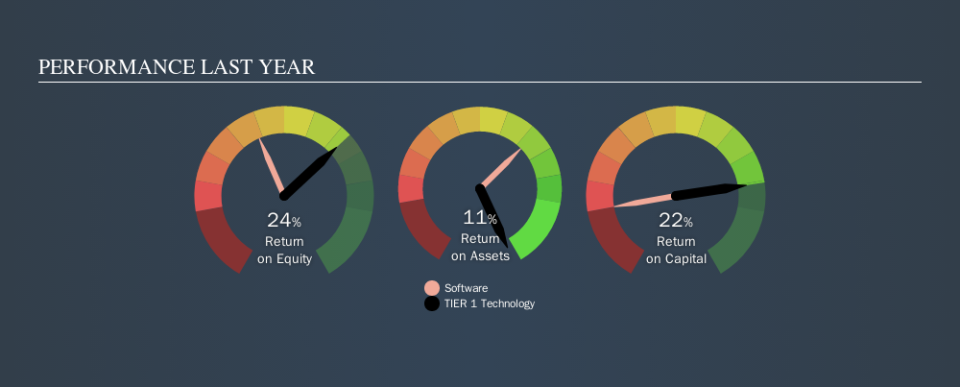Are TIER 1 Technology, S.A.’s (BME:TR1) High Returns Really That Great?

Today we are going to look at TIER 1 Technology, S.A. (BME:TR1) to see whether it might be an attractive investment prospect. To be precise, we'll consider its Return On Capital Employed (ROCE), as that will inform our view of the quality of the business.
Firstly, we'll go over how we calculate ROCE. Then we'll compare its ROCE to similar companies. Last but not least, we'll look at what impact its current liabilities have on its ROCE.
Return On Capital Employed (ROCE): What is it?
ROCE measures the amount of pre-tax profits a company can generate from the capital employed in its business. Generally speaking a higher ROCE is better. Ultimately, it is a useful but imperfect metric. Author Edwin Whiting says to be careful when comparing the ROCE of different businesses, since 'No two businesses are exactly alike.
How Do You Calculate Return On Capital Employed?
The formula for calculating the return on capital employed is:
Return on Capital Employed = Earnings Before Interest and Tax (EBIT) ÷ (Total Assets - Current Liabilities)
Or for TIER 1 Technology:
0.22 = €913k ÷ (€6.9m - €2.7m) (Based on the trailing twelve months to December 2018.)
So, TIER 1 Technology has an ROCE of 22%.
View our latest analysis for TIER 1 Technology
Does TIER 1 Technology Have A Good ROCE?
ROCE can be useful when making comparisons, such as between similar companies. TIER 1 Technology's ROCE appears to be substantially greater than the 13% average in the Software industry. We would consider this a positive, as it suggests it is using capital more effectively than other similar companies. Regardless of the industry comparison, in absolute terms, TIER 1 Technology's ROCE currently appears to be excellent.
You can click on the image below to see (in greater detail) how TIER 1 Technology's past growth compares to other companies.
When considering ROCE, bear in mind that it reflects the past and does not necessarily predict the future. ROCE can be misleading for companies in cyclical industries, with returns looking impressive during the boom times, but very weak during the busts. This is because ROCE only looks at one year, instead of considering returns across a whole cycle. How cyclical is TIER 1 Technology? You can see for yourself by looking at this free graph of past earnings, revenue and cash flow.
How TIER 1 Technology's Current Liabilities Impact Its ROCE
Liabilities, such as supplier bills and bank overdrafts, are referred to as current liabilities if they need to be paid within 12 months. Due to the way ROCE is calculated, a high level of current liabilities makes a company look as though it has less capital employed, and thus can (sometimes unfairly) boost the ROCE. To counteract this, we check if a company has high current liabilities, relative to its total assets.
TIER 1 Technology has total liabilities of €2.7m and total assets of €6.9m. Therefore its current liabilities are equivalent to approximately 40% of its total assets. A medium level of current liabilities boosts TIER 1 Technology's ROCE somewhat.
What We Can Learn From TIER 1 Technology's ROCE
Despite this, it reports a high ROCE, and may be worth investigating further. There might be better investments than TIER 1 Technology out there, but you will have to work hard to find them . These promising businesses with rapidly growing earnings might be right up your alley.
I will like TIER 1 Technology better if I see some big insider buys. While we wait, check out this free list of growing companies with considerable, recent, insider buying.
We aim to bring you long-term focused research analysis driven by fundamental data. Note that our analysis may not factor in the latest price-sensitive company announcements or qualitative material.
If you spot an error that warrants correction, please contact the editor at editorial-team@simplywallst.com. This article by Simply Wall St is general in nature. It does not constitute a recommendation to buy or sell any stock, and does not take account of your objectives, or your financial situation. Simply Wall St has no position in the stocks mentioned. Thank you for reading.

